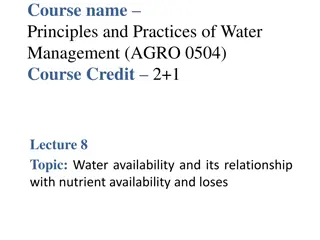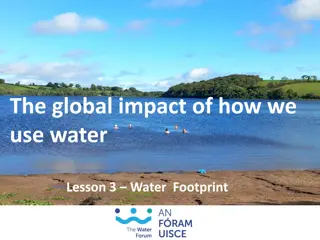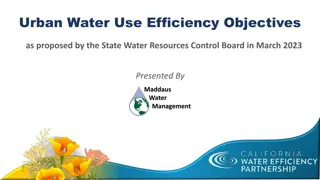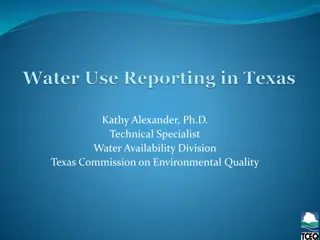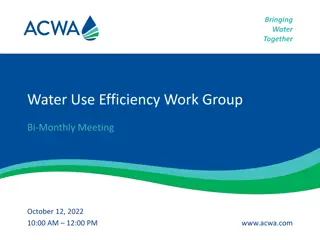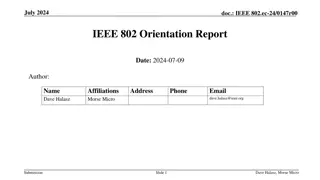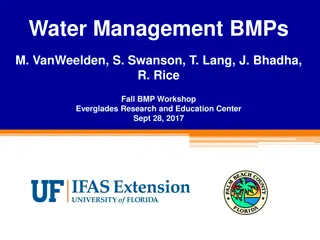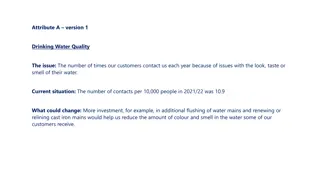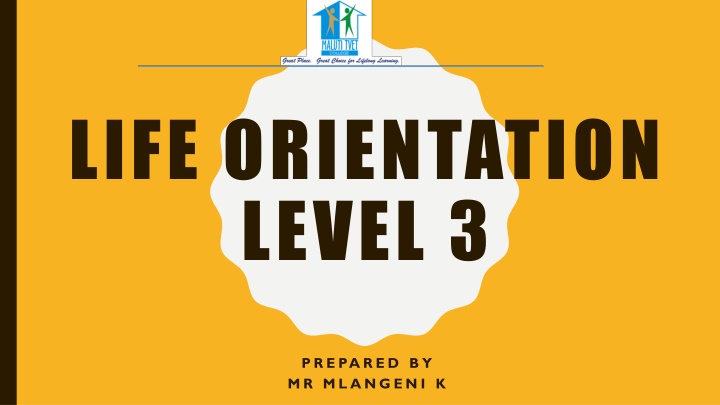
Water Safety Measures and Dangers: Be Prepared and Stay Informed
Learn essential water safety measures and precautions to avoid accidents and assist victims. Understand the risks associated with water bodies and how to stay safe while enjoying aquatic activities. Stay informed and prepared to handle potential dangers effectively.
Download Presentation

Please find below an Image/Link to download the presentation.
The content on the website is provided AS IS for your information and personal use only. It may not be sold, licensed, or shared on other websites without obtaining consent from the author. If you encounter any issues during the download, it is possible that the publisher has removed the file from their server.
You are allowed to download the files provided on this website for personal or commercial use, subject to the condition that they are used lawfully. All files are the property of their respective owners.
The content on the website is provided AS IS for your information and personal use only. It may not be sold, licensed, or shared on other websites without obtaining consent from the author.
E N D
Presentation Transcript
LIFE ORIENTATION LEVEL 3 P R E PA R E D B Y M R M L A N G E N I K
AFTER COMPLETING THIS LESSON, YOU WILL BE ABLE TO: Explain water safety measures Identify potential risk situations near or in water Explain safety measures to avoid water accidents Describe basic first aid skills to assist victims of near-drowning / water accidents
INTRODUCTION Access to basic water is a basic human right. Without water we cannot grow crops, bathe, keep our clothes clean or quench our thirst. We need water in order to survive. However it is important to know that water can be dangerous.
DANGERS OF WATER Reservoirs, rivers, disused quarries and other water bodies can be perfect places to spend a day, but they can be dangerous. Water may look safe, but it can be hazardous, which is why it's important to spot and keep away from dangers Unattended waters like rivers, lakes, and reservoirs and out-of-bound areas such as quarries, treatment works can seem like exciting places to explore. But they can be full of dangers.
RISK SITUATION Situation where there's a potential danger. Things that can harm you or cause you to drown or make you hurt yourself.
THE DANGERS OF WATER INCLUDE: Very cold temperatures - the water can be colder than expected, even in warm weather Hidden currents - there can be strong underwater currents, which can trouble even the most confident of swimmers Reservoirs are often very deep - it is difficult to estimate depth and they can be deeper than people expect There may be hidden debris or underwater hazards which can cause injury, including weeds and plants which can entangle people under the water It can be very difficult to get out (steep slimy banks) There are no lifeguards on duty The remoteness of some of these places can also hamper and delay rescue attempts
TIPS ON STAYING SAFE Ideally people, especially children, shouldn t go anywhere near quarries, treatment works or construction sites. But if there is a place like this nearby, people should: Obey danger signs - reservoirs and treatment works can be dangerous places, so stay well away Never climb on barriers and fences - they are there to protect people from serious injury and accidents around construction sites Stay away from trenches and open manholes - they are dirty, deep and may contain hazardous gases Keep clear of equipment - don t be tempted to touch diggers, lorries, pipes and other equipment A swim or a dip in a reservoir, quarry or lake may seem like a great idea, particularly on a very warm day, but it could all end in tragedy. Don t take the risk.
THE FOLLOWING ARE IMPORTANT TIPS TO FOLLOW AT ALL TIMES AT THE POOL. Supervise children at all times. ... Use the buddy system. ... Make sure at least one responsible adult knows CPR. ... Keep the pool area clear of toys. ... Never dive into shallow water. ... Stay out of water during thunderstorms. ... Avoid consuming too much alcohol.
FOR THESE REASONS, PROPER PREVENTION IS ESPECIALLY IMPORTANT. JUST A FEW SIMPLE ACTIONS CAN PREVENT ACCIDENTS AND EVEN SAVE LIVES. THE FOLLOWING ARE IMPORTANT TIPS TO FOLLOW AT ALL TIMES AT THE POOL. Supervise children at all times. A responsible adult should be watching children without distractions like reading or chatting at all times. If a child is preschool aged or not yet a confident swimmer, the adult supervising should always be in reach of the child. Drowning occurs quickly and quietly, so supervisors should always be on high alert. Use the buddy system. Even adults who are strong swimmers can have an accident at the pool, so it is never safe to go to a pool alone. Go with a buddy or make sure that a lifeguard is always present. Make sure at least one responsible adult knows CPR. Having CPR skills saves lives. In the time it takes for the paramedics to arrive, a person could die. Keep the pool area clear of toys. If a toy is not being used, it should be far from the pool deck. Children may be tempted to enter the area unsupervised to play with toys and have an accident.
CONTINUING Never dive into shallow water. Less than six feet is too shallow. Stay out of water during thunderstorms. You should be out of the water for at least 30 minutes after hearing thunder or seeing lightning. Avoid consuming too much alcohol. Swimming drunk can be as dangerous as driving drunk. Remember that blow-up or foam toys are not safety devices. If a person is not confident enough to swim without these, they need an actual safety device like a life jacket. Know your limits. Exhaustion, overheating, dehydration and even trying pool tricks like flips without training can all lead to serious pool accidents. It is important to know your abilities and limits. Leave the pool before a situation can become dangerous. By following these tips, you will be much safer and much more likely to enjoy your pool experience. However, some pool accidents may be unavoidable. While many swimming pool accidents are truly no one s fault, sometimes accidents at a swimming pool can be a result of another person s negligence.
FIRST THINGS FIRST: If you suspect someone is drowning, notify a lifeguard and call for help. Do not waste anytime. If you've pulled a drowning person back to dry land, the next step to reviving them is performing mouth-to-mouth resuscitation. As always, call for help before beginning these important first aid emergency measures. You should implement universal safety guidelines whenever possible. If you have an airway bag in your first aid kit, use it! It will provide safety during mouth-to-mouth resuscitation, keeping HIV and other infections at bay. Steps for Mouth-to-Mouth Resuscitation Turn the drowning person's head to the side, allowing any water to drain from his or her mouth and nose. Turn the head back to the centre. Begin mouth-to-mouth resuscitation on land, if possible, or in the water if the injured person needs immediate life-and-death measures. Strongly breathe four times into the mouth of the injured person as you pinch his or her nose. This helps air get past any water that is clogging the breathing passageways and the lungs. After four strong breaths, put your ear near the mouth and watch the chest for any breathing movement. Check the pulse for signs of life. Repeat the cycle.
STEPS FOR MOUTH-TO-MOUTH RESUSCITATION Turn the drowning person's head to the side, allowing any water to drain from his or her mouth and nose. Turn the head back to the centre. Begin mouth-to-mouth resuscitation on land, if possible, or in the water if the injured person needs immediate life-and-death measures. Strongly breathe four times into the mouth of the injured person as you pinch his or her nose. This helps air get past any water that is clogging the breathing passageways and the lungs. After four strong breaths, put your ear near the mouth and watch the chest for any breathing movement. Check the pulse for signs of life. Repeat the cycle.
IF THERE IS NO PULSE, START CPR Carefully place person on back. For an adult or child, place the heel of one hand on the centre of the chest at the nipple line. You can also push with one hand on top of the other. For an infant, place two fingers on the breastbone. For an adult or child, press down at least 2 inches. Make sure not to press on ribs. For an infant, press down about 1 and 1/2 inches. Make sure not to press on the end of the breastbone. Do chest compressions only, at the rate of 100-120 per minute or more. Let the chest rise completely between pushes. Check to see if the person has started breathing. Note that these instructions are not meant to replace CPR training. Classes are available through the American Red Cross, local hospitals, and other organizations.
AN ACTIVITY TO DO: Activity 13-Page 131 Activity 14-Page 133 Activity 15-Page 134
EDUCATION IS THE MOVEMENT FROM DARKNESS TO LIGHT



